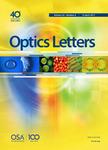版权所有:内蒙古大学图书馆 技术提供:维普资讯• 智图
内蒙古自治区呼和浩特市赛罕区大学西街235号 邮编: 010021

作者机构:Inst Nacl Astrofis Opt & Electr Dept Opt Tonantzintla 72840 Mexico Univ Guadalajara Dept Elect Guadalajara 44840 Jalisco Mexico Kingston Univ London Fac Sci Engn & Comp Kingston Upon Thames KT1 2EE Surrey England Ctr Invest Opt Leon 37150 Mexico
出 版 物:《OPTICS LETTERS》 (光学快报)
年 卷 期:2015年第40卷第17期
页 面:3990-3993页
核心收录:
学科分类:070207[理学-光学] 07[理学] 08[工学] 0803[工学-光学工程] 0702[理学-物理学]
基 金:Consejo Nacional de Ciencia y Tecnologia (CONACYT) Fight for Sight UK [1319/1320]
主 题:Inhomogeneous optical media Computation methods Ray trajectories in inhomogeneous media Gradient-index lenses Vision color and visual optics Visual optics modeling
摘 要:A new lens model based on the gradient-index Luneburg lens and composed of two oblate half spheroids of different curvatures is presented. The spherically symmetric Luneburg lens is modified to create continuous isoindicial contours and to incorporate curvatures that are similar to those found in a human lens. The imaging capabilities of the model and the changes in the gradient index profile are tested for five object distances, for a fixed geometry and for a fixed image distance. The central refractive index decreases with decreasing object distance. This indicates that in order to focus at the same image distance as is required in the eye, a decrease in refractive power is needed for rays from closer objects that meet the lens surface at steeper angles compared to rays from more distant objects. This ensures a highly focused image with no spherical aberration. (C) 2015 Optical Society of America